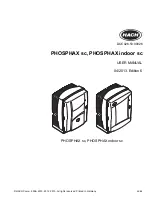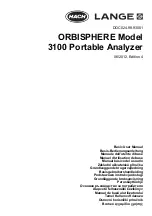
2-26
Voltage and Temperature Measurements
Standard cell comparisons
Standard cell comparisons are conducted by measuring the potential difference between a
reference and an unknown standard cell. All cell differences are determined in series opposition
configuration. The positive terminals of the standard cells (V1 and V2) are connected to the HI
and LO inputs of the nanovoltmeter, as shown in
A. The Model 2107 Input Cable
(supplied with the Model 2182) should be used to connect the cells to the nanovoltmeter in order
to minimize errors caused by thermal EMFs (V
EMF
).
Figure 2-13
Standard cell comparison measurements
Once the measurement connections have been made, care must be taken to avoid errors from
thermally generated potentials. To minimize the effects of thermal EMFs, a second measurement
is taken with the nanovoltmeter leads reversed, as shown in
B. The small voltage
difference is calculated by averaging the absolute values of the two readings. Calculation of
standard deviation across several redundant readings will help provide this assurance.
Once stability has been achieved, the actual voltage difference between the cells is measured.
For each comparison, several readings are usually averaged. This process of comparing is then
repeated each week, month, or year, depending upon the standards laboratory. The results can
then be plotted and compared over time.
HI
HI
LO
LO
DCV1
CH 1
CH 2
2182
+
-
V
EMF
+
-
+
-
V1
V2
Standard Cells
HI
HI
LO
LO
DCV1
CH 1
CH 2
2182
+
-
+
-
+
-
V1
V2
Standard Cells
A) Reading #1
Reading #1 = V1 - V2 + V
EMF
B) Reading #2
Reading #2 =V
EMF
Thermal EMFs
V
EMF
Thermal EMFs
+ (V
2
- V
1
)
Summary of Contents for 2182
Page 1: ...www tek com keithley Model 2182 2182A Nanovoltmeter User s Manual 2182A 900 01 Rev B May 2017...
Page 18: ......
Page 22: ......
Page 23: ...1 Getting Started Getting Started...
Page 41: ...2 VoltageandTemperature Measurements Voltageand Temperature Measurements...
Page 68: ...2 28 Voltage and Temperature Measurements...
Page 69: ...3 Range Digits Rate andFilter Range Digits Rate andFilter...
Page 82: ...3 14 Range Digits Rate and Filter...
Page 83: ...4 Relative mX b and Percent Relative mX b andPercent...
Page 91: ...5 RatioandDelta Ratioand Delta...
Page 117: ...6 Buffer Buffer...
Page 123: ...7 Triggering Triggering...
Page 140: ...7 18 Triggering...
Page 141: ...8 Limits Limits...
Page 149: ...9 SteppingandScanning Steppingand Scanning...
Page 168: ...9 20 Stepping and Scanning...
Page 169: ...10 AnalogOutput Analog Output...
Page 175: ...11 RemoteOperation Remote Operation...
Page 205: ...12 CommonCommands Common Commands...
Page 221: ...13 SCPISignalOriented Measurement Commands SCPISignalOri entedMeasure ment Commands...
Page 225: ...14 SCPIReferenceTables SCPIRefer enceTables...
Page 239: ...15 AdditionalSCPI Commands Additional SCPICom mands...
Page 260: ...15 22 Additional SCPI Commands...
Page 261: ...A Specifications Specifications...
Page 263: ...B Statusand ErrorMessages StatusandError Messages...
Page 268: ...B 6 Status and Error Messages...
Page 269: ...C Measurement Considerations Measurement Consider ations...
Page 278: ...C 10 Measurement Considerations...
Page 279: ...D Model182Emulation Commands Model182 EmulationCom mands...
Page 284: ...D 6 Model 182 Emulation Commands...
Page 285: ...E Example Programs ExamplePro grams...
Page 293: ...F IEEE 488 BusOverview IEEE 488Bus Overview...
Page 307: ...G IEEE 488andSCPI ConformanceInformation IEEE 488and SCPIConform anceInforma tion...
Page 310: ...G 4 IEEE 488 and SCPI Conformance Information...
Page 311: ...H Measurement Queries Measurement Queries...
Page 316: ...H 6 Measurement Queries...
Page 317: ...I Delta PulseDelta and DifferentialConductance Delta Pulse Deltaand Dif ferentialCon ductance...
















































